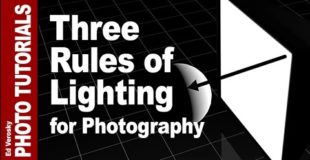The three important rules regarding the behavior of light. Use these rules to achieve the type of lighting we want, including the look of soft light. Make sure to SUBSCRIBE to this channel for more videos! Gear and recommendations below:
Subscribe to this channel: http://bit.ly/EdVeroskyYoutube
GET CONNECTED
——————
► BLOG: https://veroskycourses.com
► NEWSLETTER: http://bit.ly/veroskyNL
► FACEBOOK: https://www.facebook.com/edverosky/
► TWITTER: https://twitter.com/edverosky
► INSTAGRAM: https://www.instagram.com/edverosky
GEAR
——————
► Ed Verosky Recommends: http://bit.ly/2t3fAxe
*Affiliate Partnerships. Many of the links I provide to 3rd-party products or services are affiliate links. It doesn’t cost you anything extra to use these links, but if you do, the seller will pay me a small referral fee.
-~-~~-~~~-~~-~-
Please watch: “4 LIGHTING SETUPS YOU SHOULD KNOW”
-~-~~-~~~-~~-~-
Original source

38 responses to “Three Rules of Lighting for Photography”
Nice:)
the ball and softbox explanation would only be 100% correct if the softbox was replaced with an exposed bulb, "diffused" light leaves the softbox, light path pattern is randomized
I watch on YT…"trillions" topics regarding about …lighting !!Yours, snapping the fingers !!!! Who give …negative, in my opinion, have NO neurones for "lighting" .I'm one of your …recently subscriber, and I recommend your channel to my friend ,to !!!!
Three extremely complex principles explained perfectly and in a way even I understood.
What sort of maladjusted imbecile would give a video like this a thumbs down? Great info, succinct and well presented. Some people are just miserable gits.
Great info. Thank you!
can i use Your video in my channel with my language.
Thank you very much for the videos!
Your teaching is great and very helpful.Thanks
nice video
Thank you!
great video! thanks
Great stuff, these basics are so often over looked.
Great video, I already knew the rules but it was great to see the physics behind it explained in diagrams.
thank you very much sir !
Such A Great technical explaination of the basic rules of lighting.
Thanks a lot..
Excellent video Ed.
Great technical explaination of the basic rules of lighting.
The supporting graphics make your spoken concepts easier to grasp!
Ron
I don't need to watch your excellently made video over and over. Yes, a soft box is not a point source. Light is behaving different from inverse square law because inverse square law is only for point sources.It's not because of light's duality. It has nothing to do with that in fact.
If you get to within the distance of about 70% of the length of the light source then your luminance will not obey inverse square law. Usually this isn't useful. Sometimes it may be.
Mark, replay the video, repeatedly if necessary until you understand rule number 1.
In a way you are correct, light has a wave and particle duality, so if you look at it sufficiently magnified to see the wave, light zig-zags like a car going down a highway bouncing off guardrails on each side, but the highway is still straight and mostly we are not examining light at that scale in photography.
Keep in mind a softbox is not a single point light source.
Nice summary, I love it!
Keep in mind rule 1 is a good one but doesn't work as you get close to a line or plane source. So getting close to a kino (Sp?) or large soft box you need other rules. You could just use a light meter.
Great video Ed. I learned a lot. Thanks!!!
Christopher
well ok.
mokotumbles(DOT)tumblr(DOT)com
I have a page I sell from, as well.
Good thing you're not going into photography.
Physics in Photography
Rules schmules. See picture – push button. Upload to instagram.
You are thinking about this way too hard brah. Its just photography.
Damned fine breakdown for the more mathematically obtuse among us, that is, me. Nice.
Many thanks . Really good short informative video
light is a wave. It's trajectory/path is known as a ray. It can be called a 'ray' of light because that is what it is, however, to be more precise, some scientists/mathematicians etc. will call it a wave.
It is particulate because of it's visual form if photographed (the photons), however, these particulate things come in various wavelengths and i forgot how to finish the rest of this answer. Hope it helps, and that someone super intelligent finished the rest of your question!
this is supercool !
What is the difference between light waves and light rays?
I'm confused because the frequency of visible light can be described as both particulate and wave form.
Also, how does interference and diffraction play into these rules?
Thank you for helping me to understand this.
"liked"
explained very beautiful thanks Verosky
Nice and easy to understand….Thanks so much.
I've never heard this explained so clearly before, well done
Excellent video Ed! Great visuals and clear explanations.